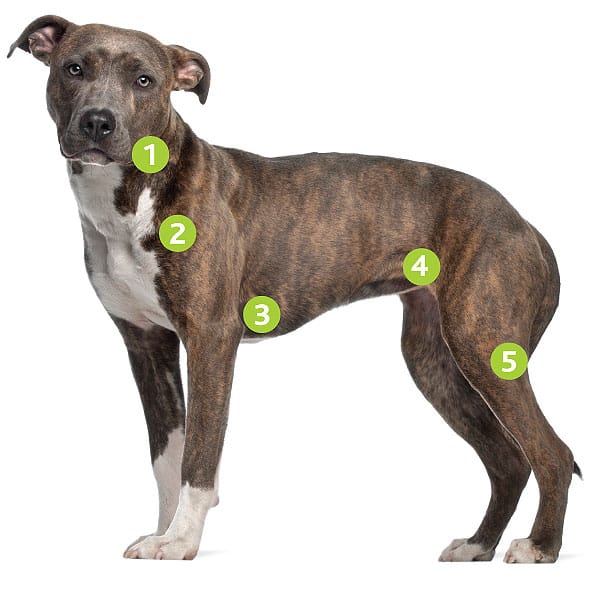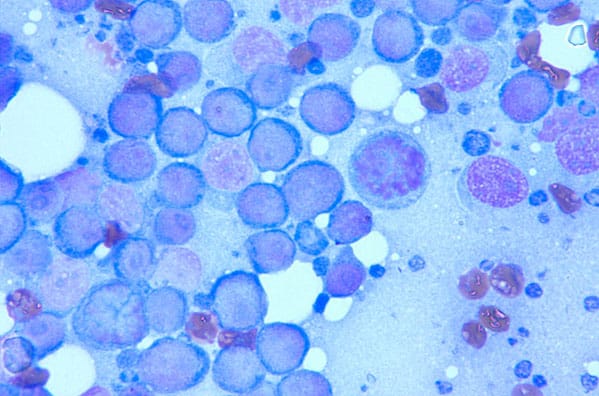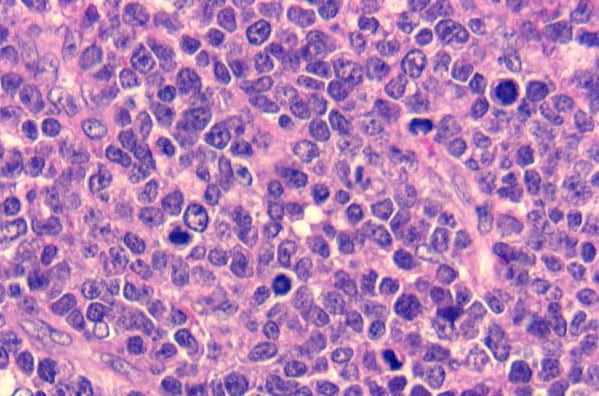
What is lymphoma?
Lymphoma is a cancer of the lymphatic system. The lymphatic system is, amongst other things, involved in immunity and fighting infections. Lymphoma arises from cells in the lymphatic system called lymphocytes which normally travel around the body, so this form of cancer is usually widespread.
Lymph nodes (sometimes called lymph glands) are part of the lymphatic system and are located all over the body. Lymphoma can affect some or all of the lymph nodes at the same time. It may be possible to feel or see affected lymph nodes that are near the body surface (as shown in the picture below) – they usually feel big and firm. Lymph nodes deeper inside the body are also often involved, as well as internal organs such as the liver, spleen, and bone marrow. This widespread involvement is not like tumour spread in other types of cancer.
Lymph nodes you can feel
- Submandibular: under the jaw
- Prescapular: in front of the shoulder
- Axillary: in the armpit
- Inguinal: in the groin
- Popliteal: behind the knee
What tests will my dog have?
The diagnosis of lymphoma is usually confirmed by taking a sample from a lymph node, either by fine needle aspirate or biopsy. Fine needle aspirate of a superficial lymph node is a quick, simple procedure using a needle (similar to those used for booster injections) to collect cells from the node. It causes minimal discomfort and is normally carried out while a patient is awake or under mild sedation. In some cases we need to take a biopsy, involving the removal of a larger sample of tissue – this may be carried out under a general anaesthetic. These tests allow a very accurate assessment of the tumour by a Specialist looking at the samples under a microscope.

A fine needle aspirate sample of lymphoma cells seen under the microscope

A solid biopsy of an affected lymph node, viewed under the microscope
Frequently, patients will have samples obtained from their enlarged lymph nodes with a fine needle, just as they do for a fine needle aspirate as mentioned already, and these samples are then sent to a Specialist laboratory for a test called ‘Flow Cytometry’. This is a very new test in canine lymphoma. It allows us to characterise the lymphoma cells much more accurately than we could otherwise manage and it can have a significant impact on prognosis and our decision-making relating to treatment.
To allow evaluation of internal lymph nodes and organs, patients usually have X-rays and an ultrasound scan. Mild sedation is usually required for these procedures, as we need our patients to be very still. Blood sampling is also performed to assess a patient’s general health status.
In some cases we will recommend taking samples of bone marrow to investigate whether or not cancer cells are present in the bone marrow. This procedure is usually carried out under a short general anaesthetic.
All the diagnostic information we obtain allows us to give an accurate prognosis and to discuss appropriate treatment options.
Can lymphoma be treated?
The simple answer is yes. It is very uncommon for lymphoma to be cured, but treatment can make your dog feel well again for a period of time, with minimal side effects. This is called disease remission, when the lymphoma is not completely eliminated but is not present at detectable levels.
Without treatment, survival times for dogs with lymphoma are variable, depending on the tumour type and extent of the disease, but for the most common type of lymphoma the average survival time without treatment is 4 to 6 weeks. With current chemotherapy regimes such as so-called “CHOP” protocols, the average survival time for the most common type of lymphoma is approximately 18 months.
Treatment options will be discussed in detail on an individual patient basis. Options include:
Steroid treatment (Prednisolone):
by itself this increases average survival times to 1 to 3 months, but it does not work in all cases. It will also make subsequent treatment with chemotherapy less successful.
Chemotherapy:
using medications to stop or hinder cancer cells in the process of growth and division.
What does chemotherapy involve?
On each treatment day, before receiving chemotherapy, your pet’s progress is discussed, together with a full physical examination and blood tests. Following this assessment, chemotherapy doses are calculated and the drugs are administered either subcutaneously (under the skin), intravenously (into a vein) via a catheter, or orally. For many patients, once a complete remission has been established, sometimes even before this, we will encourage your local vet to participate in the chemotherapy protocol too. It is important to achieve a balance between seeing the Specialist sufficiently frequently that the right decisions can be made about therapy and seeing your local veterinary practice sufficiently frequently that they are familiar with your pet’s complaint and how it is progressing.
Chemotherapy with a ‘CHOP’ protocol involves your pet receiving chemotherapy treatments approximately weekly for four weeks out of every five for four and a half to six months. At the end of the treatment plan, if your dog is in remission, therapy will be discontinued. Chemotherapy can be restarted when a patient relapses i.e. when lymphoma comes back. Patients are individuals, so the response varies from case to case, and because of this, all patients receiving chemotherapy are carefully monitored and protocols are adjusted to suit the individual.
Chemotherapy with a ‘lomustine-based’ protocol involves a heavier reliance on an oral therapy. The decision to pursue this treatment plan is driven by the characteristics of the cancer rather than a simple preference for a treatment with fewer injections.
What are the potential side effects of chemotherapy and how can they be minimised?
Side effects can be seen because chemotherapy agents damage both cancer and normal rapidly dividing cells. Normal tissues that are typically affected include the cells of the intestine, bone marrow (which makes the red blood cells, white blood cells and cell fragments involved in blood clotting called platelets) and hair follicles. Hair loss is uncommon in dogs having chemotherapy, but it can be seen in certain breeds that have a continuously growing coat, such as Poodles and Old English Sheepdogs (cats rarely develop hair loss, but may lose their whiskers). Hair usually grows back once chemotherapy is discontinued. Damage to the cells of the intestines can result in changes in appetite or stool consistency and occasionally vomiting. Damage to the bone marrow reduces blood cell production, particularly white blood cells that fight bacterial infection (neutrophils).
Steroids are often used in combination with chemotherapy. These medications can make patients feel that they want to eat and drink more (especially during the first week of therapy when doses are usually higher). Patients should not have their access to drinking water restricted, but it is important not to increase their food intake, as excess weight gain can be problematic. The increased thirst is associated with increased urination, so patients may also need to go out to pass urine more often.
Cyclophosphamide, one of the commonly used chemotherapy agents, can cause irritation to the lining of the bladder, producing cystitis-like signs. You may be asked to bring urine samples to an appointment. You should monitor your pet’s urination very carefully, and to promptly report any signs of problems.
Doxorubicin, another chemotherapy agent, can cause damage to the heart muscle over time. The more doses your dog has, the greater the risk. For this reason, heart checks are carried out during the treatment course. The nature of those checks is determined by our level of concern about a possible heart problem. Heart complications are extremely uncommon and your dog is at much greater risk if the lymphoma is not treated. There is a medication that dramatically reduces the risk of heart-related problems. We would always use this if we knew we were going to have to administer a significant number of doxorubicin doses.
We prescribe medications to help to prevent complications, and we will advise you on which signs to monitor. Compared to human patients who receive chemotherapy, pets experience fewer and less severe side effects, and these can usually be managed at home. This is because we use lower drug doses and do not combine as many drugs as in human medicine. Your pet’s quality of life is really important to us, just as it is to you.
What precautions do I need to take at home, with my pet having chemotherapy?
Chemotherapy agents can be excreted in the urine and faeces, and care must be taken when handling your pet’s waste. You will be advised of appropriate precautions, and it is important to note explicitly that pregnant women should avoid contact with the pet’s waste following chemotherapy.
What should I look out for?
Signs of gastrointestinal upset: if your pet has vomiting or diarrhoea for more than 24 hours please contact us or your usual vet. Also watch for particularly dark coloured faeces (black).
Signs of bone marrow suppression: Neutrophils (infection-fighting white blood cells) are at their lowest point usually 5 to 7 days after treatment. If your pet is depressed, off its food, panting excessively or is hot to the touch at this time, please contact us.
Signs of bladder problems: you should alert us if your dog is urinating more frequently than he or she has been, is straining or having difficulty passing urine, or if you see blood in the urine.
What will happen in the future?
Unfortunately, chemotherapy for lymphoma is very unlikely to cure your pet, but will allow a good quality of life to be enjoyed for some time. Inevitably, the cancer cells become resistant to the drugs we use, and the cancer will come back. At this stage, it is usually possible to get the cancer back under control, either by restarting the same chemotherapy protocol that we used originally (if the remission was reasonably long-lasting the first time) or by instituting treatment with alternative agents (this is known as a ‘rescue’ treatment). Eventually, the tumour cells will become resistant again and it is likely that your pet will have to be put to sleep when his or her quality of life deteriorates.
Hopefully, this will be after many happy months of good quality life for your pet and you to enjoy together.
If you have any queries or concerns, please do not hesitate to contact us.
Arranging a referral for your pet
If you would like to refer your pet to see one of our Specialists please visit our Arranging a Referral page.